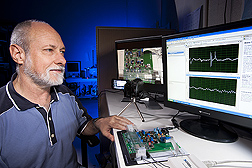New Device Eavesdrops on Insect Pests
|
|
Grain elevators, warehouses, and food-processing facilities are a hungry insect’s delight, thanks to ample food and climate-controlled conditions. Fortunately, there are many effective strategies for keeping stored-product insects in check—including targeting of problem areas with extra sanitation measures and baits. But determining pest whereabouts and numbers in order to effectively implement these strategies can be challenging.
Now, after 8 years of research, Agricultural Research Service entomologist Richard Mankin and colleagues may have some inexpensive help. Using commercially available parts, they’ve built a monitoring device that detects insects by the sounds they make.
Collaborating with Mankin are North Carolina State University researchers Ryan Hodges, Troy Nagel, and Coby Schal, all in Raleigh; and Roberto Pereira and Philip Koehler, both at the University of Florida in Gainesville.
The most likely application will be to automate routine monitoring of industrial-scale traps, especially those placed in hard-to-reach areas like crawl spaces or near food-processing equipment. “Automation could be useful in a situation where you have a trap in place for a long time and you don’t want to have to check it every week or two,” says Mankin, at the ARS Center for Medical, Agricultural, and Veterinary Entomology in Gainesville.
Armed with automated traps, managers could improve the timing and placement of control measures or even avoid using them when there’s no need. The researchers’ insect intelligence gathering isn’t restricted to stored-product pests, though. They’re also targeting home intruders like Blattella germanica (the German cockroach) and Cimex lectularius, better known as the “bed bug.”
Mankin says their objective was to create a device that would make automated insect monitoring not only affordable, but also easy to use and reliable. Toward that end, they integrated commercially available sensors (LEDs, microphones, and piezoelectric film) with high-gain amplifiers and laptop-run software for analyzing digital signals.
Their system uses the sensors to collect infrared, acoustic, and vibrational signals generated by three kinds of insect movements: wriggling, crawling, and scraping. The software analyzes the signals to create a profile of the target insect that distinguishes it from other species.
The researchers tested their device on three stored-product pests (rice weevil, red flour beetle, and drugstore beetle) and two household pests (German cockroach and bed bug). Individuals of each pest were placed inside small arenas where their signals could be collected and analyzed for differences in profile, magnitude, and duration. Although all five species generated all types of signals, red flour beetles mostly wriggled, German cockroaches typically ran or crawled, and bed bugs mostly scraped.
Mankin envisions users placing the devices in traps in or near infested structures and monitoring them remotely via laptop computer. “You would probably receive an alarm when a potential target insect was detected,” he says. “The information could also be saved in a spreadsheet, with the time of occurrence and probability that this was a target insect.”—By Jan Suszkiw, Agricultural Research Service Information Staff.
This research is part of Crop Protection and Quarantine, an ARS national program (#304) described at www.nps.ars.usda.gov.
Richard Mankin is in the USDA-ARS Insect Behavior and Biocontrol Research Unit, Center for Medical, Agricultural, and Veterinary Entomology, 1700 S.W. 23rd Dr., Gainesville, FL 32608; (352) 374-5774.
"New Device Eavesdrops on Insect Pests" was published in the March 2011 issue of Agricultural Research magazine.







